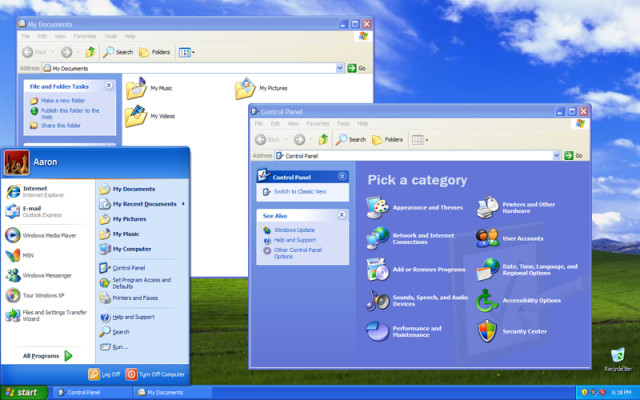In the annals of personal computing history, few operating systems have left an indelible mark like Windows XP. Released by Microsoft on October 25, 2001, Windows XP was a groundbreaking iteration that redefined the user experience, introducing features that would shape the trajectory of digital interaction for years to come. This comprehensive exploration delves into the evolution of user-friendly computing, tracing the Windows XP features that played a pivotal role in transforming the digital landscape.
1. Luna: A Visual Paradigm Shift
At the heart of Windows XP’s appeal was the introduction of the Luna interface, a departure from the stark and utilitarian designs of its predecessors. Luna embraced a vibrant color scheme, introducing a refreshing visual overhaul. The Start menu, adorned with the iconic green Start button, became the focal point of the desktop, offering users an intuitive gateway to applications and system settings. Luna marked a paradigm shift, setting the stage for the aesthetically pleasing interfaces that would become a hallmark of modern operating systems.
2. Multimedia Marvels: Windows Media Player 8 and DirectX 8.1
Windows XP elevated multimedia experiences with Windows Media Player 8. This iteration brought forth improved performance, CD ripping capabilities, and support for a plethora of multimedia formats. Users could now seamlessly enjoy music, videos, and streaming content. Complementing this was DirectX 8.1, a multimedia API that revolutionized gaming and graphics on Windows XP. These innovations laid the foundation for the immersive multimedia experiences that are now integral to our digital lives.
3. System Restore: Rewriting the Error Recovery Script
Acknowledging the frustration users faced with system errors and crashes, Windows XP introduced the groundbreaking System Restore feature. This tool empowered users to roll back their system files and settings to a previous state, effectively undoing changes that led to instability. System Restore provided a safety net for users experimenting with system configurations, reducing the anxiety associated with irreversible consequences. Its introduction marked a significant stride towards user-friendly computing.
4. Wi-Fi Integration: Connecting the World Wirelessly
Windows XP foresaw the wireless revolution and seamlessly integrated Wi-Fi networking into its framework. This feature simplified the process of connecting to Wi-Fi networks, making wireless connectivity accessible to a broader user base. Windows XP played a pivotal role in popularizing wireless networking, laying the foundation for the ubiquitous wireless landscape that defines contemporary computing.
5. Windows XP Mode: Bridging the Compatibility Gap
Understanding the importance of maintaining compatibility with legacy applications, Windows XP introduced the innovative Windows XP Mode. Available in later editions like Windows 7 Professional, Enterprise, and Ultimate, this feature allowed users to run applications designed for Windows XP on newer operating systems. By encapsulating a virtualized Windows XP environment, this mode ensured backward compatibility, enabling businesses and users to transition to newer systems without sacrificing access to critical legacy software.
6. Windows Firewall and Automatic Updates: Fortifying System Security
In response to the evolving threat landscape, Windows XP prioritized security with the inclusion of Windows Firewall. This built-in firewall acted as a barrier against unauthorized access and potential malware threats, enhancing the operating system’s defenses. Additionally, Windows XP introduced Automatic Updates, a feature that streamlined the process of receiving critical updates, security patches, and driver updates directly from Microsoft. These security measures marked a significant leap forward in safeguarding user systems.
7. Remote Assistance and Remote Desktop: Redefining Collaboration
Windows XP anticipated the growing need for remote collaboration and technical support with the introduction of Remote Assistance and Remote Desktop functionalities. Remote Assistance allowed users to seek help by granting access to their desktop, while Remote Desktop empowered users to access their computers from remote locations. These features laid the groundwork for the remote connectivity tools that have become integral to our digital workflows.
8. DirectX 9 and Gaming Evolution
For gaming enthusiasts, Windows XP introduced DirectX 9, a multimedia API that not only enhanced the visual quality of games but also introduced advanced graphics features. This innovation played a crucial role in shaping the gaming industry, laying the foundation for the immersive and visually stunning games we experience today.
9. Legacy and Enduring Impact
While Windows XP reached its end of support in 2014, its legacy endures. Many of the features introduced in Windows XP have become foundational elements of modern operating systems. The user-friendly interface, multimedia enhancements, security measures, and networking capabilities pioneered by Windows XP continue to influence the design and functionality of contemporary operating systems.
10. Conclusion: Windows XP’s Lasting Legacy
In conclusion, the evolution of user-friendly computing found a landmark moment in Windows XP. Its features not only transformed the digital landscape during its heyday but continue to influence the way we interact with technology today. As we reflect on this iconic operating system, we recognize its enduring legacy in the features that have become standard in modern computing. Windows XP, with its revolutionary spirit, remains a beacon in the history of user-friendly computing.
